
For Beginners LLC
155 Main Street, Suite 211
Danbury, CT 06810 USA
www.forbeginnersbooks.com
Copyright 2016 Steve Bachmann
Illustrations Copyright 2016 Van Howell
This book is sold subject to the condition that it shall not, by way of trade or otherwise, be lent, re-sold, hired out, or otherwise circulated without the publisher's prior consent in any form of binding or cover other than that in which it is published and without a similar condition being imposed on the subsequent purchaser.
All rights reserved. No part of this publication may be reproduced, stored in a retrieval system, or transmitted in any form or by any means, electronic, mechanical, photocopying, recording, or otherwise, without prior permission of the publisher.
A For Beginners Documentary Comic Book
Copyright 2016
Cataloging-in-Publication information is available from the Library of Congress.
ISBN # 978-1-939994-44-8 Trade
Manufactured in the United States of America
For Beginners and Beginners Documentary Comic Books are published by For Beginners LLC.
First Edition
10 9 8 7 6 5 4 3 2 1
www.redwheelweiser.com
www.redwheelweiser.com/newsletter

I WOULD LIKE TO DEDICATE THIS BOOK to the oases of civilization that helped to inspire it and make it possible, viz., the new and used book stores of Barcelona, Spain; Harvard Square, Cambridge; Hyde Park, Chicago; Notre Dame, South Bend; and Madison, Wisconsin. And thanks to France for planting the Albertine bookstore at Fifth and 79th in New York City.
A LSO, I WOULD LIKE TO THANK my colleagues and mentors in French: Ellen Bachmannhuff, Ruth Benner, Celia Brickman, Jacquie Erwin, Trina Hikel, and Dan Snow.

Passages quoted from In Search of Lost Time carry a volume and page reference (in parentheses at the end) corresponding to the relevant edition.
All passages from Swann's Way (Volume I) are quoted directly from the original English translation by C.K. Scott Moncrieff and Terence Kilmartin (New York: Henry Holt, 1922).
S hort excerpts from the succeeding volumes (II-VI) come from the most recent revision of the full Moncrieff/Kilmartin translation, by D.J. Enright (In Search of Lost Time. New York: Modern Library, 1992, 1993.)
For longer passages in volumes II-VI, the author of this work has provided his own translations; in these instances, the word see precedes corresponding volume and page references to the Enright edition.
S imilarly, short quotes from Against Sainte-Beuve are from Sylvia Townsend Warner's translation in Proust: On Art and Literature (New York: Carroll and Graf, 1984); longer passages are translated by the author of this work, with see referring to corresponding pages in Warner.
All other excerpts and quotationsfrom Proust and otherscome from the sources cited in Credit Where Credit is Due or Further Reading.

What, Who, Where, When, How

IN MY VIEW, THE CRITIC... SHOULD TRY TO RECONSTRUCT THE PECULIAR LIFE OF THE SPIRIT WHICH BELONGS TO EVERY WRITER WHO IS OBSESSED BY HIS OWN SPECIAL VIEW OF REALITY.... [E]XISTENCE FOR HIM HAS NO JUSTIFICATION SAVE AS BEING THE SOLE POSSIBLE MEDIUM THROUGH WHICH HE CAN MAKE CONTACT WITH REALITY.
MARCEL PROUST, A MASSACRE OF CHURCHES
Foreword
by Harold Augenbraum
D uring the past hundred years and more, since the 1913 publication of Swann's Way (in French, Du ct du chez Swann), Prousthis name and his works are often used synonymouslyhas developed a reputation for being difficult to read. Climbing Mount Proust is a phrase sometimes used to describe the experience.
 roust is indeed often difficult to fathom, perhaps because his style of writing is so different from that of his predecessors (he cares little for plot and less about action) or because the reach of his reference is so broad and deep. You have to work slowly. His sentences can run as long as 958 words (in translation), their subject and predicate separated by dozens of subordinate clauses. This type of stylistic dilation, to steal a very descriptive word from poet and critic Richard Howard, adds both richness and complexity. It allows Proust to fill each passage with personal, cultural, and literary quotation and allusion, which has defined not only his writing but much of the literature of the early twentieth century, a period of great artistic foment. (James Joyce and T.S. Eliot also took the whole of their experience of civilization as a palette.) If, in an earlier age of transition, Cervantes' Don Quixote was flummoxed by the great adventure writers in his library of medieval tales, Proust's narrator also imbibes, embraces, and then pays homage to every one and every thing he had ever read, which Proust himself did in his poetry, letters, pastiches, articles, and conversation, and his use of painting, architecture and music during his novel's composition.
roust is indeed often difficult to fathom, perhaps because his style of writing is so different from that of his predecessors (he cares little for plot and less about action) or because the reach of his reference is so broad and deep. You have to work slowly. His sentences can run as long as 958 words (in translation), their subject and predicate separated by dozens of subordinate clauses. This type of stylistic dilation, to steal a very descriptive word from poet and critic Richard Howard, adds both richness and complexity. It allows Proust to fill each passage with personal, cultural, and literary quotation and allusion, which has defined not only his writing but much of the literature of the early twentieth century, a period of great artistic foment. (James Joyce and T.S. Eliot also took the whole of their experience of civilization as a palette.) If, in an earlier age of transition, Cervantes' Don Quixote was flummoxed by the great adventure writers in his library of medieval tales, Proust's narrator also imbibes, embraces, and then pays homage to every one and every thing he had ever read, which Proust himself did in his poetry, letters, pastiches, articles, and conversation, and his use of painting, architecture and music during his novel's composition.
A rt is only one of Proust's universes, however. Marcel Proust lived during a period of great political and social upheaval in continental Europe. His parents were married on the day after France fell to the Prussians; the day after the wedding, France declared its Third Republic. He was born amid echoes of gunfire during the Paris Commune. If in the 1830s and 1840s his precursor, Honor de Balzac, had chronicled the redistribution of power from France's landowners to its business lite, Proust would describe (also in fiction) the last gasp of that landed aristocracy's descent into sleaze. Three years before the publication of Swann's Way, Edward VII of Britain, whom Proust included as a ghostly presence in Charles Swann's social world, had been laid to rest in London in what the historian Barbara Tuchman called the last state funeral attended by the world's great monarchiesthe event that marked the end of the culture of monarchy. The great nineteenth-century novelists, such as mile Zola, would focus on commerce. Proust's interest lay not in the great fortunes and the fortunate themselves, but in the interstices, where the self-made were connected to the remnants of high society, where the transitions of many political and social eras left a rich vein of Time that Proust could explore as a fourth dimension. To Proust, mutability would become metaphor.
T o call Proust a social or political novelist alone, a novelist of aesthetics, or even a novelist of Time, however, is to limit the scope of his intention. Among the great achievements of In Search of Lost Time (a barely adequate translation of the original French, la recherche du temps perdu) are, indeed, the characters that Proust created, the embedding of the arts, real and invented, and the effects of the passage of time.
B ut his true brilliance lies in the stylistically consistent and always evolving depiction of a single consciousness, set within the narrative framework of a fictionalized autobiography. Proust's narrator relentlessly layers what seems like thinking on the page. (The section Swann in Love, written in the third person, is an exceptions to this). He constantly reads himselfand others, if he can employ their lives in the project of understanding himself. By the time you finish the seven volumes, you want to start again from the beginning. Imagine if you could gradually recall and then put into context everything you had ever experienced, all the events of your life and then use it all to understand why you have become who you are. Reading Proust is not a blueprint for how you should live, it's a guide to reading the world. This is what the young Marcel Proust learned from the English critic John Ruskin, the hero of his early adulthood: The examined life is a function of constant observation and reiteration.
Next page

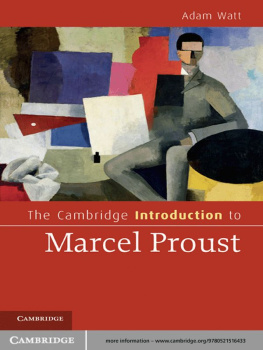

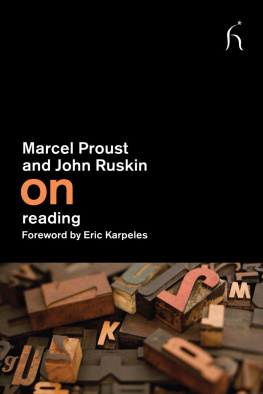

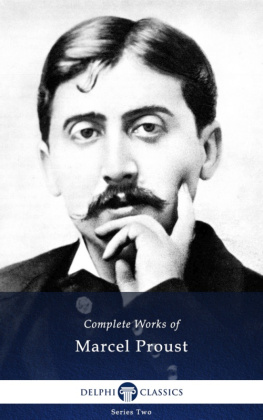
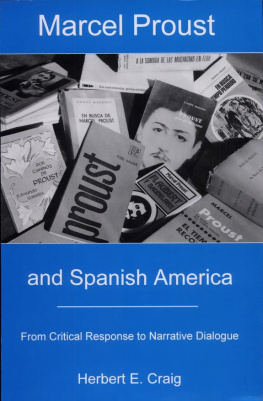

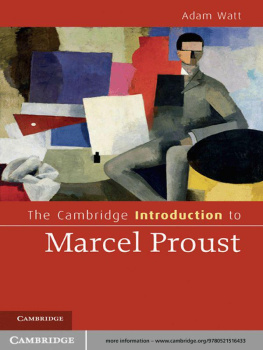





 roust is indeed often difficult to fathom, perhaps because his style of writing is so different from that of his predecessors (he cares little for plot and less about action) or because the reach of his reference is so broad and deep. You have to work slowly. His sentences can run as long as 958 words (in translation), their subject and predicate separated by dozens of subordinate clauses. This type of stylistic dilation, to steal a very descriptive word from poet and critic Richard Howard, adds both richness and complexity. It allows Proust to fill each passage with personal, cultural, and literary quotation and allusion, which has defined not only his writing but much of the literature of the early twentieth century, a period of great artistic foment. (James Joyce and T.S. Eliot also took the whole of their experience of civilization as a palette.) If, in an earlier age of transition, Cervantes' Don Quixote was flummoxed by the great adventure writers in his library of medieval tales, Proust's narrator also imbibes, embraces, and then pays homage to every one and every thing he had ever read, which Proust himself did in his poetry, letters, pastiches, articles, and conversation, and his use of painting, architecture and music during his novel's composition.
roust is indeed often difficult to fathom, perhaps because his style of writing is so different from that of his predecessors (he cares little for plot and less about action) or because the reach of his reference is so broad and deep. You have to work slowly. His sentences can run as long as 958 words (in translation), their subject and predicate separated by dozens of subordinate clauses. This type of stylistic dilation, to steal a very descriptive word from poet and critic Richard Howard, adds both richness and complexity. It allows Proust to fill each passage with personal, cultural, and literary quotation and allusion, which has defined not only his writing but much of the literature of the early twentieth century, a period of great artistic foment. (James Joyce and T.S. Eliot also took the whole of their experience of civilization as a palette.) If, in an earlier age of transition, Cervantes' Don Quixote was flummoxed by the great adventure writers in his library of medieval tales, Proust's narrator also imbibes, embraces, and then pays homage to every one and every thing he had ever read, which Proust himself did in his poetry, letters, pastiches, articles, and conversation, and his use of painting, architecture and music during his novel's composition.